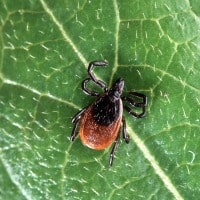The black-legged tick is now settled in twice the number of counties it occupied in 1998, according to the US Centers for Disease Control, and has broadened its territory in the northeastern states and the upper Midwest. Following its onward march, across the Ohio River valley, western New York and the shores of Lake Michigan since the 1990s, there has been a tripling in the incidence of Lyme disease in the US.
The tick, which is a variant species present on the west coast of the US, can tunnel into humans and transmit Lyme disease, which causes fever, headache and other flu-like symptoms. Further problems include impaired memory, dizziness, heart palpitations and inflammation of the brain and spinal cord. Around 300,000 people are diagnosed with Lyme disease each year. The CDC said there has been a 320% increase in the number of counties in the northeast US considered high risk for Lyme disease since the 1990s. Overall, more than 45% of all American counties now host the ticks, up from 30% in 1998, according to the research published in the Journal of Medical Entomology.
Reforestation and an increased population of deer, which host the ticks, have contributed to the increase in distribution. Temperature and rainfall also influence the fate of the tick, with a warming climate helping their spread. Dr Rebecca Eisen, a research biologist at the CDC, said the tick expansion has been “substantial” and required mitigating action, especially in areas that have not previously had to deal with the insects. “The tick is now established in areas where it was absent 20 years ago,” she states.
The spread of ticks won’t necessarily lead to a uniform increase in Lyme disease cases, because of the varying presence of the infected spirochetes that are passed on, as well as uneven numbers of the ticks themselves. However, people in areas at risk of Lyme disease are suggested to use repellent, walk in the middle of trails when out hiking and bathe or shower as soon as possible when coming indoors. This will help remove attached ticks. Luckily, there is no evidence that Lyme disease is becoming harder to treat. The ticks should also face natural obstacles in their journey across the states.




